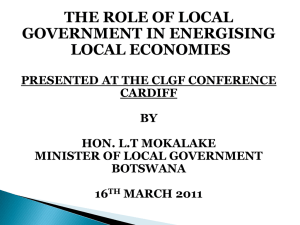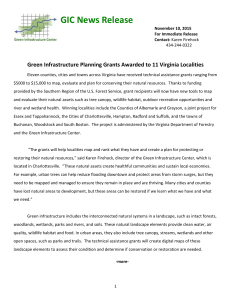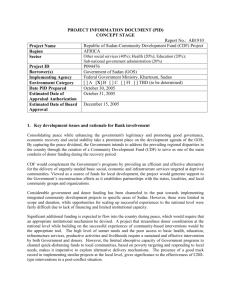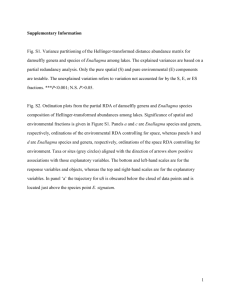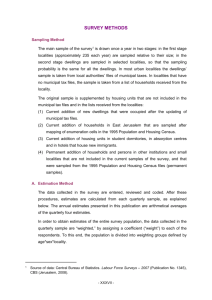Evolutionary biology: Common Ground
advertisement
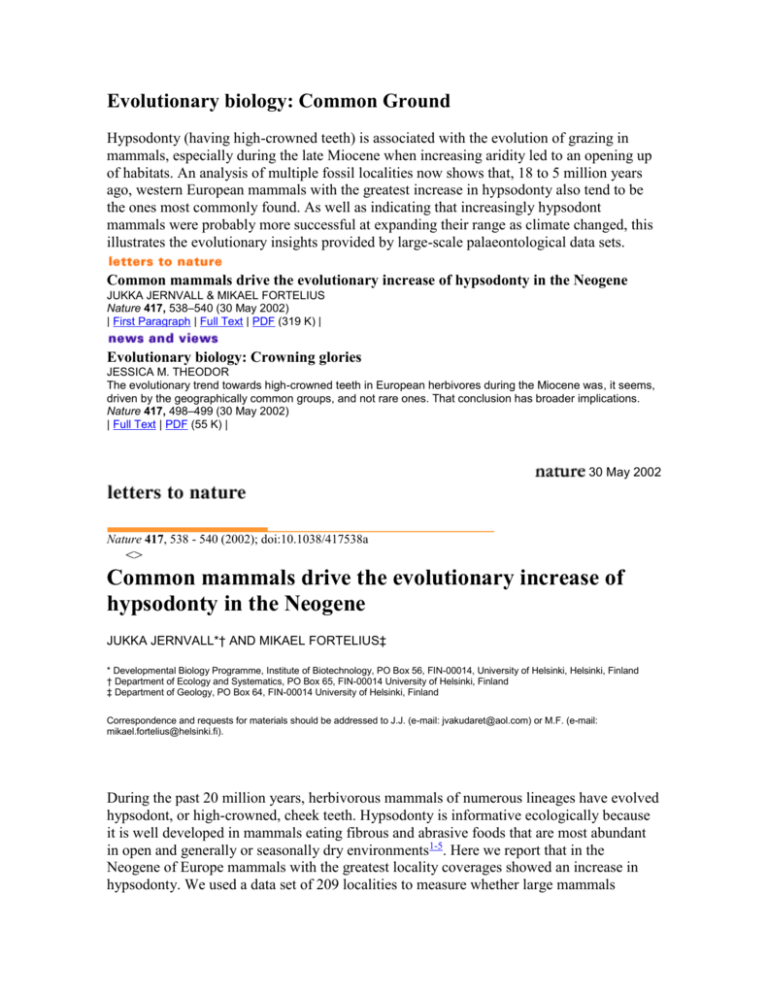
Evolutionary biology: Common Ground Hypsodonty (having high-crowned teeth) is associated with the evolution of grazing in mammals, especially during the late Miocene when increasing aridity led to an opening up of habitats. An analysis of multiple fossil localities now shows that, 18 to 5 million years ago, western European mammals with the greatest increase in hypsodonty also tend to be the ones most commonly found. As well as indicating that increasingly hypsodont mammals were probably more successful at expanding their range as climate changed, this illustrates the evolutionary insights provided by large-scale palaeontological data sets. Common mammals drive the evolutionary increase of hypsodonty in the Neogene JUKKA JERNVALL & MIKAEL FORTELIUS Nature 417, 538–540 (30 May 2002) | First Paragraph | Full Text | PDF (319 K) | Evolutionary biology: Crowning glories JESSICA M. THEODOR The evolutionary trend towards high-crowned teeth in European herbivores during the Miocene was, it seems, driven by the geographically common groups, and not rare ones. That conclusion has broader implications. Nature 417, 498–499 (30 May 2002) | Full Text | PDF (55 K) | 30 May 2002 Nature 417, 538 - 540 (2002); doi:10.1038/417538a <> Common mammals drive the evolutionary increase of hypsodonty in the Neogene JUKKA JERNVALL*† AND MIKAEL FORTELIUS‡ * Developmental Biology Programme, Institute of Biotechnology, PO Box 56, FIN-00014, University of Helsinki, Helsinki, Finland † Department of Ecology and Systematics, PO Box 65, FIN-00014 University of Helsinki, Finland ‡ Department of Geology, PO Box 64, FIN-00014 University of Helsinki, Finland Correspondence and requests for materials should be addressed to J.J. (e-mail: jvakudaret@aol.com) or M.F. (e-mail: mikael.fortelius@helsinki.fi). During the past 20 million years, herbivorous mammals of numerous lineages have evolved hypsodont, or high-crowned, cheek teeth. Hypsodonty is informative ecologically because it is well developed in mammals eating fibrous and abrasive foods that are most abundant in open and generally or seasonally dry environments1-5. Here we report that in the Neogene of Europe mammals with the greatest locality coverages showed an increase in hypsodonty. We used a data set of 209 localities to measure whether large mammals occurring in many fossil localities show a similar increase in hypsodonty to mammals occurring in single or few localities. Taxonomic and morphological groupings show a low average hypsodonty in the early Miocene epoch. From the middle Miocene onwards, only the hypsodonty of commonly found mammals shows a marked increase. Therefore, in the drying Europe of the late Miocene, only increasingly hypsodont mammals may have been able to expand their share of habitats and food resources. These results suggest that the relatively small number of species known from multiple localities are palaeoecologically informative by themselves, irrespective of the rest of the known species. Palaeoecological inference relies on information derived from individual fossil localities. Increased sampling and methods that correct for uneven sampling6, 7 or are insensitive to sampling8, 9 allow a more accurate, less biased description of evolutionary patterns. Large data sets including numerous localities now allow us to evaluate new aspects of community evolution, such as whether species found in many localities show similar palaeoecological changes to those of species found in a limited number of localities. This information is lost when conventional tabulations of regional faunal lists are used for analysis, because every species is tabulated only once. Such analyses tend to over-emphasize rare taxa, whose specializations may not reflect overall trends in the biota. We used the NOW database of Eurasian Neogene fossil mammals (http://www.helsinki.fi/science/now/), from which we included European localities up to 20° E longitude. This area corresponds roughly to 'West' of previous analyses of western Eurasian Neogene mammals, an area found to represent a biogeographically and biochronologically relatively uniform region9; thus providing a good geographic scale for exploring the effects of environmental change on biota10. The localities from 18 to 5 million years (Myr) ago were divided into nine intervals corresponding to the MN (Mammal Neogene) units 4 to 13 of European mammal chronology11-13. The number of localities in each interval ranged from 10 to 37 with a relatively constant geographic coverage (Fig. 1). We present here the results after grouping localities that are within one degree of geographic separation from each other in each time interval. This grouping makes the analysis more conservative as multiple-locality complexes (such as Oberdorf, Austria) may bias the results, although equivalent results were obtained using the ungrouped set of localities. We included all large, non-carnivorous mammals in the analysis. Three classes of tooth crown height recorded in the database were assigned the values 1, 2 and 3, respectively: low (brachydont), medium high (mesodont) and high (hypsodont). This is a relatively conservative tabulation as the difference in crown height between a hypsodont and a brachydont species is usually more than 3:1. We tabulated hypsodonty values for species, genera and cheek tooth crown types. We placed more emphasis on the genus and crown-type level tabulations because even after correcting for known synonyms (see the NOW database above), species level inferences may be biased by the high number of species found at very few localities (36 to 57 per cent of species have one locality occurrence in each MN unit). The ecomorphological crown type tabulation is based on tooth morphology alone and cuts across taxonomic groups14, 15. Figure 1 The nine locality intervals and number of localities (in parenthesis) analysed. Full legend High resolution image and legend (92k) First we examined changes in hypsodonty in taxa that are common (defined as present in more than 25 per cent of localities within an MN interval) as opposed to taxa which are rare (represented in less than 25 per cent of localities). The results show that the average hypsodonty increased markedly in the late Miocene in common genera (Fig. 2a). In contrast, rare genera show less change in their hypsodonty. Moreover, in the early Miocene rare genera show slightly higher hypsodonty averages than common genera (Fig. 2a). We next examined species grouped only by molar crown type. Individual crown types are sampled from more localities than genera because several taxa can share the same crown type but the pattern of results nevertheless appears similar between genera and crown types. Average hypsodonty again shows a marked increase only among common crown types in the late Miocene (Fig. 2b). This increase partly coincides with a decrease in overall sampling intensity as reflected in the number of localities known (Fig. 2c, d). Because we define frequency of occurrence in relative terms within each time interval, our analysis should be insensitive to differences in level of sampling. Figure 2 Increase in hypsodonty is limited to common groups (present at over 25 per cent of localities within MN interval). Full legend High resolution image and legend (52k) As the crown type tabulation suggests, the increase in hypsodonty among common taxa is not limited to any single taxonomic group. Of special interest are the hipparionine horses, which contribute heavily to the classic increase in hypsodonty among ungulates1. However, the increase in hypsodonty in common genera or crown types is not eliminated by removing the family Equidae or corresponding crown types from the common groups (Fig. 2a, b). Rather, hipparionine horses, many of which are found in many localities, appear as the first wave of the increase in hypsodonty followed by other ungulates later in the Neogene (Fig. 2a, b). This is evidently a result of their having evolved hypsodonty in North America before their dispersal to the Old World at the beginning of the late Miocene1, 16. A significant aspect of the results is the increase in hypsodonty among the common groups beginning around 11 Myr ago. This was a time of major climatic changes, including the first development of Eurasian mid-latitude aridity17, widely believed to have been ultimately driven by the Himalayan–Tibetan uplift18, 19. Up to that point, hypsodont mammals are confined to fewer than five localities (Fig. 2c, d). Comparing further the preand post-11-Myr-times, average locality coverage of hypsodont species (tabulations 2 and 3) increases from 11 to 18 per cent (P = 0.017, MN-randomization test on medians) and for brachydont species (tabulation 1) from 13 to 16 per cent (P = 0.054). The locality coverage of hypsodont genera increases from 12 to 25 per cent (P = 0.022) and for brachydont genera from 16 to 18 per cent (P = 0.148). Similarly, locality coverage of hypsodont crown types increases from 8 to 52 per cent (P = 0.028) and for brachydont crown types from 30 to 33 percent (P = 0.570). These changes are consistent with the documented decrease in overall provinciality9, here shown to be most conspicuous in hypsodont mammals. We propose that in the drying Europe of the late Miocene mostly mammalian lineages possessing advanced (such as the hipparionine horses) or incipient (such as many rhinoceroses and bovids) hypsodonty were able to increase their relative share of habitats and food resources. At the population level this increasing presence of hypsodont taxa may have been related to, and consistent with, life-history differences observed between modern hypsodont and brachydont ungulates, such as large group sizes found in hypsodont taxa2022 . We note that while common taxa (as defined above) appear to be also abundant in relative numbers of individuals within a locality (for example, the hipparionine horses), this will require further study when locality-specific taxon abundance data become available. The more pronounced increase in hypsodonty among common taxa is an indication that large-scale data sets provide unique insights into evolution. The most immediate implication is that common taxa could be used to retrieve and map evolutionary changes that might otherwise be swamped by noise from rare groups. Moreover, to the extent that the occurrence of fossil species in a locality may reflect past abundance23, the use of regional or global taxon presence lists may underestimate past ecological changes at the community level. We thus predict that analysis of other large-scale data sets with primary locality–occurrence information will reveal that common taxa show generally stronger evolutionary trends than do all taxa. Methods We analysed hypsodonty in species, genera and crown types of orders Artiodactyla, Perissodactyla, Primates and Proboscidea. Analyses were insensitive to details of handling genera or crown types that contained species with different hypsodonty values, and here we used averaged hypsodonty for each locality. The MN-wide hypsodonty was the average of all the localities. Four genera (Alicornops, Brachypotherium, Plesiaceratherium and Tragoportax) out of 98 genera and three crown types (L2212 (ectolophodont), L2220 (selenodont) and R2200 (bunodont)) out of 12 crown types had species with different hypsodonty values within MN units. These were also the only groups that had species with different hypsodonty values across MN units, predominantly showing an increase in hypsodonty during their temporal ranges. We assigned uncertain species (20) and genera (4) to be certain, although alternative handling did not change the pattern of results. We analysed only large mammals, which by itself should minimize taphonomic or collecting biases. All reconstructed body masses exceed 5 kg and 79 per cent of species are at least 20 kg. There are no temporal trends excluding an increase in body mass of brachydont suoids23, which, if it causes a bias, might dampen the hypsodonty trends. On the other hand, hypsodont species are 2.8 times the average mass of brachydont species (544 kg versus 197 kg), which, if it causes a bias, might exaggerate the hypsodonty trends. We note that such a bias should not affect the trends calculated separately for brachydont and hypsodont groups. In horses hypsodonty results in a more compact dental design but their exclusion did not eliminate the patterns. Exclusion of Primates and Proboscidea, which could have distinct taphonomic or collecting biases, did not alter the pattern of results. Although the MN units are distributed in time, the general problem with the application of time-series methods to fossil data is that sampling intervals and efforts vary and samples do not represent single points. Therefore, because we needed a robust measure of the overall trends in the increase of hypsodonty during the Neogene, we examined whether the medians of observed cumulative hypsodonty curves were significantly shifted to younger MN units. Such a shift would indicate a disproportional presence of high hypsodonty values in the younger MN units. We used a randomization test24 to obtain significance values for each median separately by randomly reshuffling the temporal order of MN units 1,000 times and calculating a median for each randomization (medians expected to be clustered around MN 7 + 8 and 9). These null distributions of medians provide a robust measure of trends because only overall increases or decreases depart significantly from the randomizations. For example, common groups had medians between MN 9.6 and 9.9, indicating an increase in hypsodonty, and we calculated how many times these high, or higher, values were obtained from the random distribution of medians. Because the larger number of relatively brief MN units in the late Miocene may bias the medians, we performed the analyses also after combining MN units 10 and 11, and these P values are given below in parentheses. Our primary interest was not to estimate the absolute increases but to portray trends among common and rare groups, which should be relatively insensitive to differences in MN duration. The resulting probability values for common (present at 25 per cent of localities) species, genera and crown types are P = 0.010, 0.008, 0.008 (0.017, 0.024, 0.007), and the corresponding values for rare groups are P = 0.054, 0.371, 1.000 (0.071, 0.480, 1.000). The crown types have slight decrease in hypsodonty, P = 0.157 (0.107), Fig. 2b. The values for common groups excluding hipparionine horses are P = 0.536, 0.012, 0.048 (0.598, 0.024, 0.100). The non-significant value for species results from the fact that the cut-off point defining common groups leaves only one common hipparionine species in MN 13. When common and rare groups are combined the increase in hypsodonty is intermediate. The values for species, genera and crown types are P = 0.025, 0.079, 0.032 (0.005, 0.299, 0.076). To test how the relative locality coverage increased in brachydont and hypsodont groups, we examined the shifts in medians of cumulative locality coverage curves. In the few cases where a genus or a crown type had species with a different degree of hypsodonty (see above), we considered these groups hypsodont when their locality averages of hypsodonty were at least 1.5. The probability values obtained from reshuffling MN units for hypsodont species, genera and crown types are P = 0.017, 0.022, 0.028 (0.079, 0.065, 0.013), and the corresponding values for brachydont groups are P = 0.054, 0.148, 0.570 (0.461, 0.597, 0.553). Received 26 October 2001; accepted 13 February 2002 References 1. Simpson, G. G. Horses (Oxford Univ. Press, New York, 1951) 2. Van Valen, L. A functional index of hypsodonty. Evolution 14, 531-532 (1960) | ISI | 3. Janis, C. M. & Fortelius, M. On the means whereby mammals achieve increased functional durability of their dentitions, with special reference to limiting factors. Biol. Rev. 63, 197-230 (1988) | ISI | 4. Meng, J. & McKenna, M. C. Faunal turnovers of Palaeogene mammals from the Mongolian plateau. Nature 394, 364-367 (1998) | Article | ISI | 5. MacFadden, B. J. in Evolution of Herbivory in Terrestrial Vertebrates (ed. Sues, H.-D.) 223-244 (Cambridge Univ. Press, Cambridge, 2000) 6. Alroy, J. Constant extinction, constrained diversification, and uncoordinated stasis in North American mammals. Palaeogeogr. Palaeoclimatol. Palaeoecol. 127, 285-311 (1996) | Article | ISI | 7. Alroy, J. et al. Effects of sampling standardization on estimates of Phanerozoic marine diversification. Proc. Natl Acad. Sci. USA 98, 6261-6266 (2001) | PubMed | ISI | 8. Damuth, J. Analysis of the preservation of community structure in assemblages of fossil mammals. Paleobiology 8, 434-446 (1982) | ISI | 9. Fortelius, M., et al. in The Evolution of Western Eurasian Neogene Mammal Faunas (eds Bernor, R. L., Fahlbusch, V. & Mittmann, H.-V.) 414-448 (Columbia Univ. Press, New York, 1996) 10. Barnosky, A. D. Distinguishing the effects of the Red Queen and Court Jester on Miocene mammal evolution in the northern Rocky Mountains. J. Vert. Paleontol. 21, 172-185 (2001) | ISI | 11. Mein, P. in European Neogene Mammal Chronology (eds Lindsay, E. H., Fahlbusch, V. & Mein, P.) 73-90 (Plenum, New York, 1989) 12. Steininger, F. F., et al. in The Evolution of Western Eurasian Neogene Mammal Faunas (eds Bernor, R. L., Fahlbusch, V. & Mittmann, H.-W.) 7-46 (Columbia Univ. Press, New York, 1996) 13. Alroy, J., Bernor, R. L., Fortelius, M. & Werdelin, L. The MN system: Regional or continental? Mitt. Bayerischen Staatsamlung Paläontol. Hist. Geol. 38, 243-258 (1998) 14. Jernvall, J. Mammalian molar cusp patterns: Developmental mechanisms of diversity. Acta Zool. Fennica 198, 1-61 (1995) 15. Jernvall, J., Hunter, J. P. & Fortelius, M. Molar tooth diversity, disparity, and ecology in Cenozoic Ungulate Radiations. Science 274, 1489-1492 (1996) | Article | PubMed | ISI | 16. Garcés, M., Cabrera, L., Agust', J. & Parés, J. M. Old World first appearance datum of "Hipparion" horses: Late Miocene large-mammal dispersal and global events. Geology 25, 1922 (1997) | ISI | 17. Broccoli, A. J. & Manabe, S. in Tectonic Uplift and Climate Change (ed. Ruddiman, W. F.) 89121 (Plenum, New York, 1997) 18. Ruddiman, W. F. (ed.) Tectonic Uplift and Climate (Plenum, New York, 1997) 19. An, Z., Kutzbach, J. E., Prell, W. L. & Porter, S. C. Evolution of Asian monsoons and phased uplift of the Himalaya-Tibetan plateau since Late Miocene times. Nature 411, 62-66 (2001) | Article | PubMed | 20. Jarman, P. J. The social organization of antelope in relation to their ecology. Behavior 48, 215267 (1974) | ISI | 21. Janis, C. M. Evolution of horns in ungulates: Ecology and palaeoecology. Biol. Rev. 57, 216-317 (1982) 22. Pérez-Barbería, F. J., Gordon, I. J. & Nores, C. Evolutionary transitions among feeding styles and habitats in ungulates. Evol. Ecol. Res. 3, 221-230 (2001) | ISI | 23. Fortelius, M. & Hokkanen, A. in Phylogeny of the Neogne Hominoid Primates of Eurasia (eds De Bonis, L., Koufos, G. & Andrews, A.) (Cambridge Univ. Press, Cambridge, 2001) 24. Manly, B. F. J. Randomization, Bootstrap and Monte Carlo Methods in Biology (Chapman and Hall, London, 1997) Acknowledgements. We thank A. D. Barnosky, J. Damuth, I. Hanski, J. P. Hunter and P. C. Wright for discussions and advice on this work, which was supported by the Academy of Finland. Competing interests statement. The authors declare that they have no competing financial interests. Figure 1 The nine locality intervals and number of localities (in parenthesis) analysed. The corresponding number of localities for each MN unit after grouping localities situated within one degree of geographic separation from each other are: 15, 15, 20, 20, 22, 10, 9, 7 and 14. Grouping the short-duration MN units 10 and 11 does not change the results. The average centroids along the longitude and the latitude of the taxa or crown types found in many localities (Fig. 2) did not differ from those found in fewer localities (P = 0.57 to 0.76, Mann–Whitney U-test). Figure 2 Increase in hypsodonty is limited to common groups (present at over 25 per cent of localities within MN interval). a, Average hypsodonty increases sharply in common genera (solid line) while rare taxa show very little change in hypsodonty (present in less than 25 per cent of localities, dotted line). b, Ecomorphological groupings of teeth based on crown types shows increase in hypsodonty among common crown types (solid line). We note how in the early Miocene, the common groups are less hypsodont than the rare groups. The increase in hypsodonty persists when hipparionine horses are removed from the common groups (in grey in a and b). c, The distribution of genera is well below the number (N) of localities (solid line) whereas the distribution of crown types (d) approaches the locality curve, representing the broader crosstaxonomic range of ecomorphological groupings. We note how the average hypsodonty of genera and crown types found in many localities increase in the late Miocene (large bubbles). We show genera in a and c because genus level can be considered a more robust measure of diversity. Species level tabulations gave equivalent results to the tabulation based on genera. See Methods for details. 30 May 2002 Nature 417, 498 - 499 (2002); doi:10.1038/417498a <> Evolutionary biology: Crowning glories JESSICA M. THEODOR Jessica M. Theodor is in the Department of Geology, Illinois State Museum, 1011 East Ash Street, Springfield, Illinois 62703, USA. e-mail: jtheodor@museum.state.il.us The evolutionary trend towards high-crowned teeth in European herbivores during the Miocene was, it seems, driven by the geographically common groups, and not rare ones. That conclusion has broader implications. The evolution of high-crowned teeth is one of the classic stories of evolutionary biology, but the object lesson of the story might be different from that found in the textbooks. In studying past environments, the rare and more specialized animals often get the most attention. In their paper on page 538 of this issue, however, Jernvall and Fortelius1 show that a few, common, regionally widespread species can drive major trends, yielding more information than is usually recognized. Twenty-four million years ago, at the beginning of the Miocene epoch, most herbivorous mammals had low-crowned (brachydont) cheek teeth and a few rare species had highcrowned (hypsodont) teeth. Hypsodont teeth are an adaptation to increased abrasive wear. Although high-crowned teeth are no more mechanically resistant to abrasion than lowcrowned ones, the additional height of the tooth crown means that there is more tooth to wear away over the animal's lifetime. However, these teeth are costly in terms of both the materials needed to produce them and the shape changes that must evolve in the jaws to accommodate them. Hypsodont teeth have evolved in many herbivorous lineages in response to increased abrasion, whether by the silica secreted by grasses2 or by grit in the environment stuck to plant foods3, 4. By the end of the Miocene, 5 million years ago, the situation had reversed compared with the beginning of the epoch, with hypsodont forms present at most localities. This change is attributed to increased aridity and the spread of grasslands during this time, which would increase abrasive wear by the spread of more open habitats with higher grit levels, and also by the spread of silica-bearing grasses. Jernvall and Fortelius1 examined changes in tooth crown height during the Miocene in a novel way. They tabulated hypsodonty for 209 European fossil localities by assigning each species a value corresponding to low-, medium- or high-crowned teeth, and then examined the numerical trend in those values for common animals (found in 25% or more of the localities) and rare animals (found in less than 25% of localities). Importantly, they did not compare relative abundances within localities, so that their definition of common does not imply that these animals were the most abundant ones in any given locality, but that they occurred at many localities across the region in each time interval. Rarity was assessed for each interval, so groups that were rare during one time were not necessarily rare at another. Jernvall and Fortelius examined changes in hypsodonty for species and genera over time, and found similar patterns at both taxonomic levels. In rare genera, tooth crown height stayed relatively constant. In the more geographically widespread ones, however, average hypsodonty began to increase significantly about 11 million years ago. To ensure that this pattern was not driven by particular lineages, the authors selectively removed potentially problematic groups (horses, primates and proboscideans) from the analysis: horses because in the textbook version of events they are the group that were thought to drive the trend of increasing hypsodonty; primates because they have low-crowned teeth and are relatively rare; and proboscideans because they are large and their fossils are usually more likely to be collected than those of small taxa. The pattern was still present in the remaining data. Brachydont species are often smaller than hypsodont ones, so Jernvall and Fortelius examined the degree of hypsodonty in different crown morphology types. Crown types are characterized by functional properties of the teeth, such as the number, orientation and shape of the cusps5, and should be insensitive to size differences among species. The trend of increasing hypsodonty is also found only among geographically common crown types, supporting the view that this trend is not a taxonomic artefact. The proportion of localities that include hypsodont genera and crown types increased significantly after 11 million years ago, whereas the proportion of localities with low-crowned genera and crown types did not. These results imply that drying climatic conditions in Europe, usually associated with the uplift of the Tibetan plateau6, allowed ungulates — hoofed mammals — with higher tooth crowns to expand their range as more open arid grasslands spread in Europe. Work is needed to see whether the trend in the North American fossil record, which has better temporal resolution, is also driven by common taxa. Examination of the relative abundances of taxa within localities in both continents should show whether this pattern is unique to Europe or is more widespread. Jernvall and Fortelius point out that their results are consistent with the life-history differences we see in modern ungulates. Hypsodont species are somewhat larger, and are more likely to form large herds7 and disperse more widely across landscapes, and the increase in hypsodonty among common taxa about 11 million years ago might herald the evolution of these life-history traits. But showing that these traits are associated with a trend of increasing hypsodonty in common herbivores, and are not found in the rarer ones, will require more work on the Miocene fossil record. Aspects of Jernvall and Fortelius's approach will influence future work on evolutionary trends. The use of a new metric — average hypsodonty — could prove useful as a palaeoenvironmental indicator, and provides a quantitative measure of the temporal and spatial variation in crown heights of teeth from different sites. The examination of common and rare groups has allowed the finer resolution of a major trend and might lead to a better understanding of the evolution of grassland ecosystems. It also suggests that common groups yield more information about palaeoecology than has previously been recognized. The use of large data sets to examine evolutionary trends has increased markedly in recent years, and further insights into other trends, such as changes in body size, might result from examining common and rare taxa separately. References Jernvall, J. & Fortelius, M. Nature 417, 538-540 (2002). | Article | Jacobs, B. F., Kingston, J. D. & Jacobs, L. L. Ann. Missouri Bot. Gdn 86, 590-643 (1999). | ISI | Janis, C. M. & Fortelius, M. Biol. Rev. Camb. Phil. Soc. 63, 197-230 (1988). | ISI | Janis, C. M. in Teeth Revisited: Proceedings of the VIIth International Symposium on Dental Morphology (eds Russell, D. E., Santoro, J.-P & Sigogneau-Russell, D.) 367-387 (Musée d'Histoire Naturelle, Paris, 1988). 5. Jernvall, J., Hunter, J. P. & Fortelius, M. Science 274, 1489-1492 (1996). | Article | PubMed | ISI | 6. Ruddiman, W. F. (ed.) Tectonic Uplift and Climate Change (Plenum, New York, 1997). 7. Jarman, P. J. Behavior 48, 215-267 (1974). | ISI | 1. 2. 3. 4.

